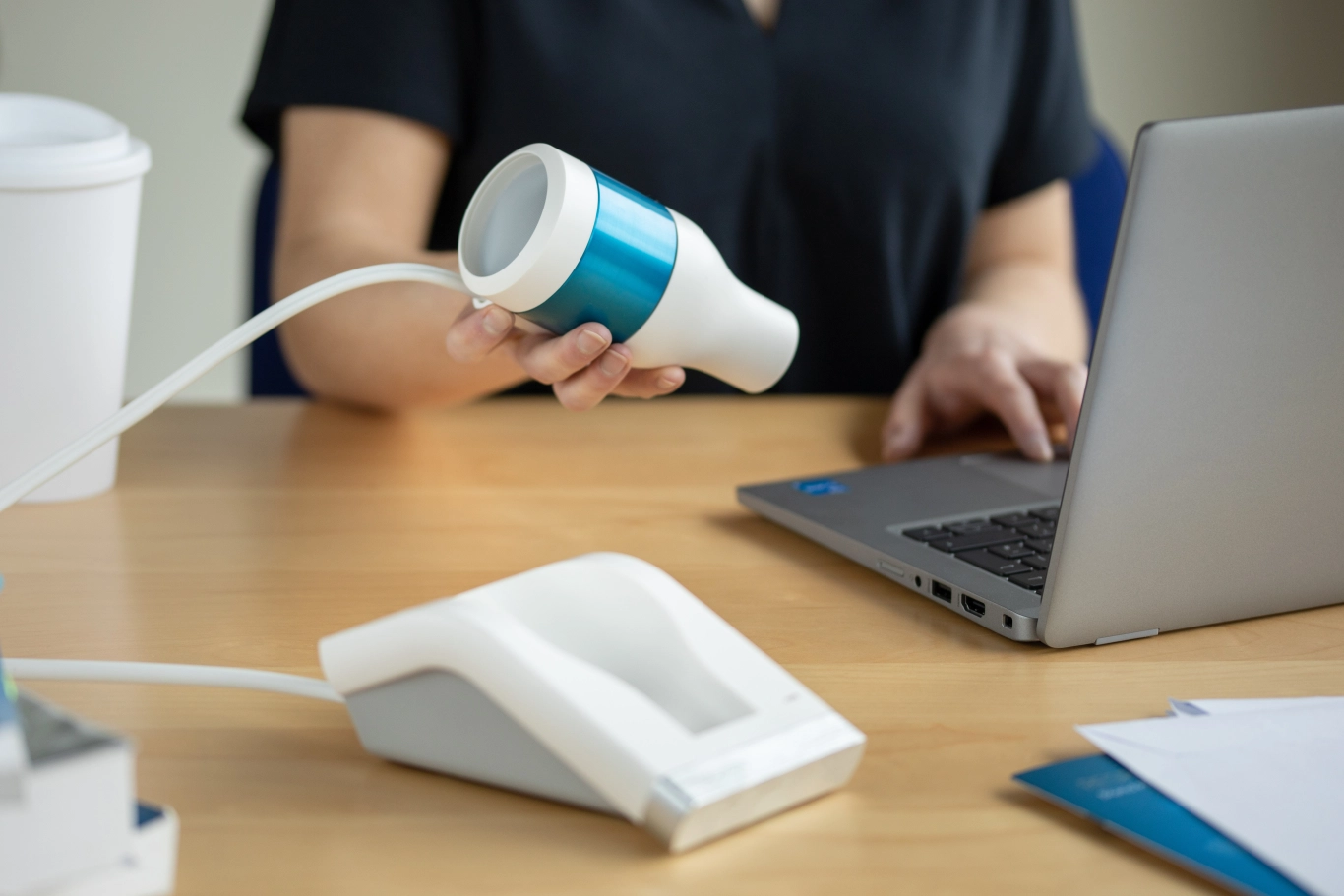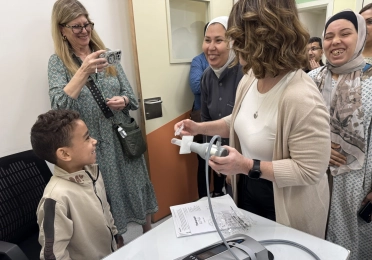Spirometry - Understanding the Flow Volume Loop
The flow-volume loop is a graphical plot that provides key insights into lung function by showing the relationship between lung volume and airflow. The graph is created during a spirometry test, capturing information during inhalation and exhalation to calculate inspiratory and expiratory volumes. These measurements are formed during the Forced Vital Capacity (FVC) manoeuver which measures the maximum volume of air that can be exhaled from the lungs from full inhalation. The FVC alongside the Vital Capacity (VC) manoeuvres are crucial in spirometry interpretation.
Traditionally, spirometry focused on measuring exhalation only, with the test ending when the subject has fully exhaled as shown in figure 1. Advances in lung function testing, with the focus being on enhancing the precision and accuracy of spirometry results led to an update ATS/ERS 2005 Standardization of Spirometry. The current ATS/ERS 2019 Standardization of Spirometry standards, emphasise the importance of incorporating both inspiratory and expiratory measurements during spirometry testing to create the flow-volume loop.
Historically, some spirometers and spirometry software only measured expiration, as well as the use of one-way valve mouth pieces. As a result, many departments routinely performed exhalation-only manoeuvres. However, new insights discussed within this article suggest that measuring inspiratory flow alongside expiration can improve test quality.
Past and Present Spirometry guidelines: 2005 v 2019
The 2005 ATS/ERS spirometry standardization outlined three main steps to obtain an FVC. Firstly, maximal inspiration, followed by a strong exhalation (blast), and finally, complete exhalation. A separate test sequence was discussed briefly for inspiration, referred to as the “Maximal Expiratory Flow Volume Loop” MFVL. In this test sequence, the subject is asked to take a rapid full inspiration to total lung capacity (TLC) from room air through the mouth, insert the mouthpiece and, without hesitation, perform an expiration with maximum force until no more gas can be expelled, followed by a quick maximum inspiration. At this point, the manoeuvre is finished, completing the loop in a single manoeuvre.
By contrast, the 2019 guidelines prioritise both inspiration and expiration within a single FVC manoeuvre. This is broken into four steps:
Maximal inspiration
A forceful exhalation
Complete exhalation and
An inspiratory manoeuvre back to total lung capacity (TLC).
This revised approach places greater importance on inspiration, as the 2019 ATS/ERS guidelines mention the parameter forced inspiratory vital capacity (FIVC), which is measured at end expiration with inhalation back to TLC. The guidelines state comparing the FVC and FIVC is key for assessing the technical acceptability of spirometry results. Only when both inspiratory and expiratory manoeuvres are performed can this comparison be made, ensuring accurate testing.
What does a normal flow-volume loop look like?
Figure 2. A well-formed flow-volume loop reflects healthy lung function. The curve shows the relationship between airflow (vertical axis) and lung volume (horizontal axis). For a normal result, the curve begins at TLC and features a peak during forceful exhalation, which gradually diminishes as lung volume decreases. The loop then curves upwards as the patient inhales back to TLC. The highest flow rate occurs at the beginning of exhalation and is effort dependent. After approximately one-third of the exhale, airflow becomes less effort-dependent and more influenced by lung pressure and airway resistance.
What does an abnormal flow-volume loop look like?
The shape of the flow-volume loop can also reveal patterns of lung disease. For example, in obstructive lung diseases like asthma or COPD, there is a reduction in maximal expiratory flow which causes the characteristic “scooping” or concave shape in the loop. This occurs because the airway collapses during forceful exhalation, reducing the airflow despite maximum effort. The severity of obstruction can be assessed by depth of the scoop as shown in figure 3 and 4.
Lung diseases that restrict lung expansion such as chest wall abnormalities or space-occupying lesions such as tumors can lead to restrictive lung disease. In these cases, the flow-volume loop will show reduced lung volumes and shorter exhalation times as shown in Figure 5.
The importance of inspiration
One of the key advantages of measuring inspiration during spirometry is the ability to capture the FIVC. Without the inspiratory maneuver FIVC cannot be obtained. FIVC can be compared with FVC to assess whether the test began at TLC. According to ATS/ERS guidelines, if the FIVC exceeds the FVC by more than 0.100 L or 5% of the FVC, it indicates that the test did not start from TLC, making the result unreliable for certain measurements such as FEV1. However, the FVC may still be acceptable. Most modern spirometers have the FIVC parameter within the parameter list and some software can offer real-time feedback on this comparison, helping operators ensure the test is conducted correctly. The comparison of FIVC and FVC can also be observed on the flow-volume loop if FIVC is obtained is bigger than FVC as shown in Figure 7.
References
Spirometry: Performance and Interpretation A Guide for General Practitioners. (2005). Available at: https://irishthoracicsociety.com/wp-content/uploads/2017/05/SpirometryGuidelinespdf.pdf
Spirometry: Performance and Interpretation A Guide for General Practitioners. (2005). Available at: https://irishthoracicsociety.com/wp-content/uploads/2017/05/SpirometryGuidelinespdf.pdf.
Graham, B.L., Steenbruggen, I., Miller, M.R., Barjaktarevic, I.Z., Cooper, B.G., Hall, G.L., Hallstrand, T.S., Kaminsky, D.A., McCarthy, K., McCormack, M.C., Oropez, C.E., Rosenfeld, M., Stanojevic, S., Swanney, M.P. and Thompson, B.R. (2019b). Standardization of Spirometry 2019 Update. An Official American Thoracic Society and European Respiratory Society Technical Statement. American Journal of Respiratory and Critical Care Medicine, [online] 200(8), pp.e70–e88. doi:https://doi.org/10.1164/rccm.201908-1590st.
Vitalograph Spirotrac 6 software.
This article originally featured in OH Today, Volume 32 Issue 1.




